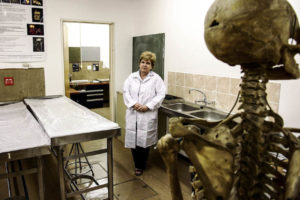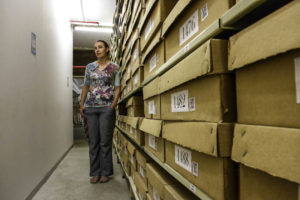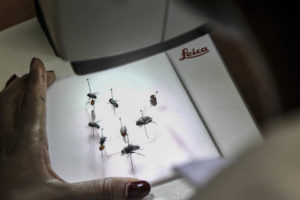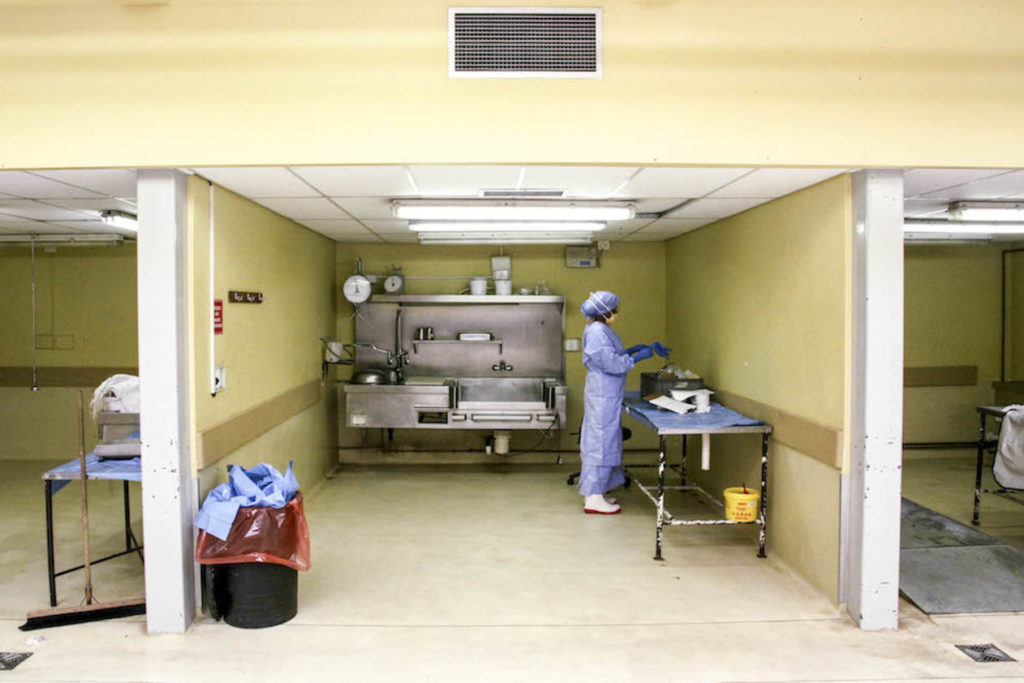Storygram: Sarah Wild’s “Bones specialists try to prise secrets from the veld bodies”
The Storygram series, in which professional writers annotate award-winning stories to illuminate what makes a great science story great, is a joint project of The Open Notebook and the Council for the Advancement of Science Writing. It is supported by a grant from the Gordon and Betty Moore Foundation.
Sarah Wild has written about astronomy, particle physics, and everything in between, and she’s published two books about science in South Africa. This annotation was done by Jen Schwartz and is co-published at The Open Notebook.
If it wasn’t for the smell, no one would know there was a body there. The savannah grass reaches above the waists of passers-by sweating under the Gauteng summer sun.
AAAS KAVLI SCIENCE JOURNALISM AWARD |
| The AAAS Kavli awards recognize distinguished science reporting by professional journalists. This story was honored with an award in 2018. |
If the body has been there for a while, the soft tissue of the face will have decomposed. There is often no identification on the body – no ID, no cellphone, no wallet – and the clothes have been shredded into faded, unrecognisable rags by the elements.
There is no data on how many of Gauteng’s 15 000 to 16 500 annual unnatural deaths are found in this way but the occurrence is common enough for these bodies to have their own moniker among the officials who dread having to deal with them: veld bodies.
Identifying them is important. A perpetrator of unnatural death could be at large. Families need to know what happened to loved ones. But it is also a near-impossible task.
To confirm someone’s identity so that it will stand up to the scrutiny of the justice system, the police need either fingerprints, a dental match or DNA. Popular television series such as NCIS and Bones show investigators using science to piece together someone’s identity from the flimsiest of evidence. But real life is not so simple and all too many of Gauteng’s veld bodies remain anonymous.
DNA breaks down when exposed to sunlight or water. Even if it is there, the police need a direct relative to compare it with. Fingerprints disappear along with a person’s soft tissue and the majority of people on the African continent do not have dental records.
So the search for identity must begin elsewhere. But where do you start when you can’t even tell whether the body is that of a male or female?

Such a veld body could end up on the stainless steel gurney of Professor Maryna Steyn, a forensic anthropologist and head of anatomical sciences at the University of the Witwatersrand.
In her laboratory in the bowels of the university’s health sciences building, collections of bones lie spread on counters, fanning out in two-dimensional skeletons. “If there’s a full body, full tissue, the forensic pathologist can handle it and do an autopsy,” she says.
A forensic pathologist, employed by the department of health in one of the country’s medico-legal laboratories, performs an autopsy to determine the person’s cause of death.
This can be difficult when a corpse is fully, or even partially, decomposed. A forensic anthropologist starts where the forensic pathologist leaves off and tries to establish from their bones a person’s identity and what happened to them.
“Once it’s skeletonised and decomposed and full of maggots and bits of flesh, it needs to be cleaned, and then from a skeleton we analyse the age, sex, ancestry, trauma,” Steyn says.
For police even to begin the process of identifying a person, they need to know a body’s sex, age and race.
This is more difficult than it sounds.
Sex is fairly easy in adults because women’s child-bearing pelvises give them away. In children, there is little sex differentiation. It is easier, though, to determine children’s ages from their bones than from those of adults. Because of their rapid skeletal growth in childhood, forensic anthropologists can tell you a child’s age to within a year.
This is useful because South Africa’s forensic anthropologists say they are receiving more children’s bodies than before.
But adults’ skeletons don’t really change until they are in their autumn years, so an age estimate can span decades.
Race is even trickier. “History is not on our side for this one,” says Professor Ericka L’Abbé, at the University of Pretoria’s Forensic Anthropology Research Centre.
In the past, scientists looked at the skeleton, particularly the skull, to confirm ideas of racial superiority. Although this racist science has been debunked, there is a stigma attached to acknowledging the biological differences between races.
“But there are differences between races and, while they have no social [value] attachment, what we are socially and how we identify ourselves socially is important for our identification. Our culture has affected our biology in that we are segregated socially, culturally, from various groups,” L’Abbé says.
“You can, with a certain probability, say this unknown person, based on these biological characteristics, will more likely align with this group than these others.”
L’Abbé has spearheaded a drive to create a database of “biological distance” for South Africans. Biological distance is the physical similarity or difference between groups of people who have been separated by time or geography. She says there is biological distance between the skeleton of a white and a black South African, but scientists cannot currently distinguish between different black groups.

South Africa is a complex continuum of race and culture. Race is not a discrete factor, with people fitting into neat boxes. “It all comes down to a game of statistics,” L’Abbé says with a sigh. “Currently, we can tell if someone is South African but we can’t really tell if they are not South African.”
This is a problem, considering the assumption that the vast majority of Gauteng’s unidentified dead are foreigners.
L’Abbé has been trying to get measurements for Shona, Ndebele and other Zimbabwean groups but she has had little success.
“We have gone to various public hospitals in the country trying to access CT scan data that could assist with this but we have run into problems: while we are asked on every single form in South Africa about our self-identified race, we are not asked it in the hospital setting. It is the only place in which we are not asked it,” she says.
Additionally, people may not admit to being from another country for fear of being discriminated against.

Complicating the matter further, there is also more to race than biological distance. How a person identifies is not necessarily the same as their physical race. Someone’s bones may show that they have strong African heritage, for example, but they identify as coloured.
Both Steyn and L’Abbé are quick to point out that this form of identification – known as presumptive identification – has its limits. “It doesn’t provide [a definitive] identification, but we’re narrowing down the possible number of people X can be, so rather than being 5 000 people, it might be 500 people,” L’Abbé says.
More research could help to narrow down this number but no one is throwing money at forensic science.
“Nobody is interested in the dead,” says Steyn. “Who will be interested to sponsor any research or a project or a lab that is helping to identify the unidentified?
“It’s not something commercial that’s going to bring in any money or that you can advertise as good work that you have done.”
But, even if it was available, all the data in the world would not in itself fix a system with fundamental problems.
The Hillbrow medico-legal facility in Johannesburg, with its annual intake of about 3 000 bodies, records its cases by hand in a large ledger. Often the writing is illegible and there’s no validation of what the person on duty writes.
AN INTERVIEW WITH SARAH WILD |
| Showcase interviewed Sarah Wild shortly after she won the award for this story. Read it here. |
Crucial information, such as the police officer’s station phone number and the crime administration system number – the unique number identifying the case – are habitually left blank.
Aside from these obvious possibilities for human error, there are more subtle opportunities for mistakes. An official may say that the man who died is black, of medium build, between the ages of 30 and 35. But there is no agreed definition of what medium build is, what a 30-year-old looks like and even the definition of black. “It’s your perception. It’s not objective; it’s subjective,” says Candice Hansmeyer, a special forensic pathologist at the Hillbrow facility.
On the other side is the family searching for a missing person – families who are also prone to human error.
“We have got family members who last saw their loved one years ago and now they have got to try remember, ‘he’s about so tall’, ‘this is what he looks like, she looks like’,” Hansmeyer says. “Hairstyles have changed, skin colours change depending on nutrition, sun exposure.”
That said, a more scientific approach would improve identification, as would a computerised system. It might also provide an idea of the scale of the problem. If you want to know how many unidentified bodies moved through the Hillbrow facility’s yellow walls, you have to check manually.
“They must get all the dockets, they must compare all the dates. It’s tedious, it’s laborious,” says Mothobi Mokheti, who is in charge of information communication technology for the forensic pathology service.
This team of one is developing and piloting a mortuary management system for the South Gauteng forensic pathology service, which includes eight facilities.
The pilot scheme involves working with forensic officers and managers in the Hillbrow laboratory to capture bodies’ data and develop the system to address forensic officials’ needs.
“The second phase is to put the missing persons section on the system,” he says.
Currently, mortuaries – even ones in the same administrative cluster – do not share easily accessible databases. The police have their own database, but that can only be used by members of the service.
“We absolutely need a database and we need to have someone who works on it with a whole lot of dedication,” says Steyn, who has worked in South African forensics for more than two decades.
“If we could put all the data together for all the morgues, and all the case studies we do [at universities], and at least have that available and try and match the missing persons against that list, I think it would be a great contribution. Just by doing a few basic things right, we’ll be able to identify quite a few people … [But] all of these case reports that we write, they are of no use unless there is someone to follow it up.”
For the very difficult cases, such as decomposed veld bodies, academics and officials are pinning their hopes on advances in science. In the past few decades, there have been remarkable improvements in identification standards, software and tools, and they hope this will continue.
“I hope that, in 10 years’ time, how we are looking at ancestry will look like old technology,” L’Abbé says. “I hope the next generation of researchers will take it so much further than we are able to do, and that in time we will improve identification.

“Until then, I will store [the bones of my unclaimed and unidentified cases] in the cupboard. Until someone comes for them.”
Jen Schwartz is a senior editor of features at Scientific American who specializes in the intersection of science and society. She has worked as an editor or reporter at Popular Science, GQ, New York, Outside, Self, and The Boston Globe, where she wrote and produced stories across a wide range of topics including technology, health, environment, climate, economics, politics, culture, and social sciences. She is a veteran researcher skilled in fact-checking and investigative reporting. She holds a B.S. in journalism with a minor in environmental science from Boston University. Follow her on Twitter at @jenlschwartz.
You may view this story in its original format at Mail & Guardian. Jen Schwartz’s Q&A with writer Sarah Wild is at The Open Notebook.

